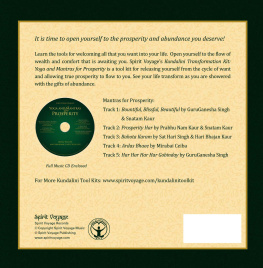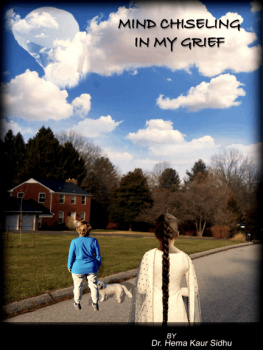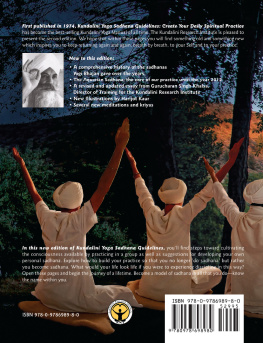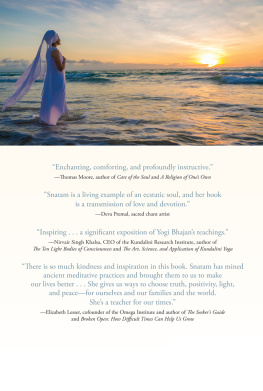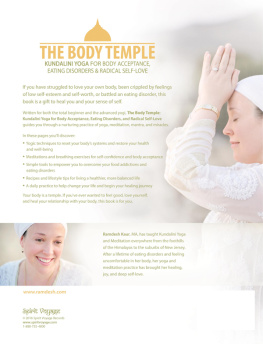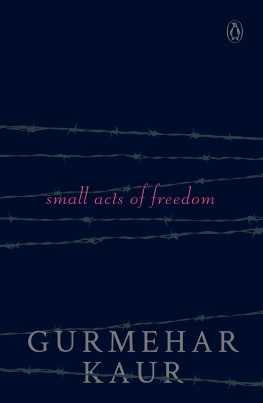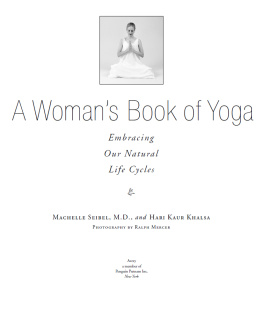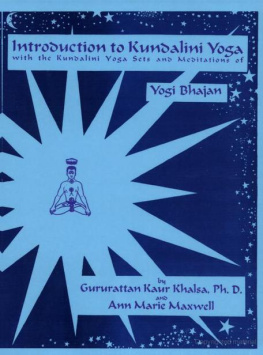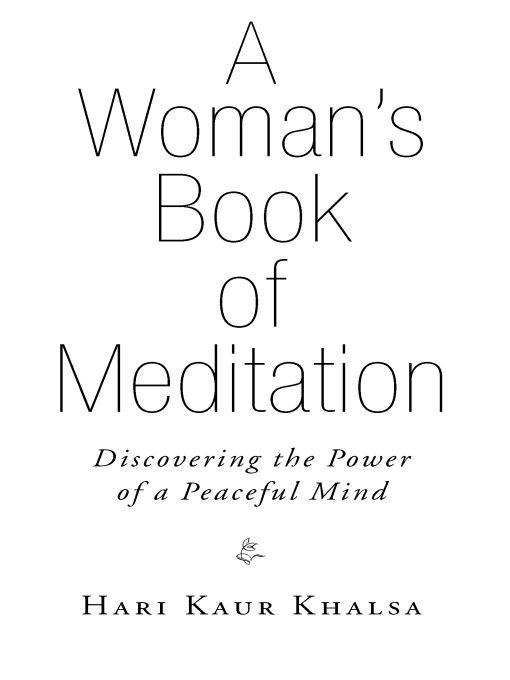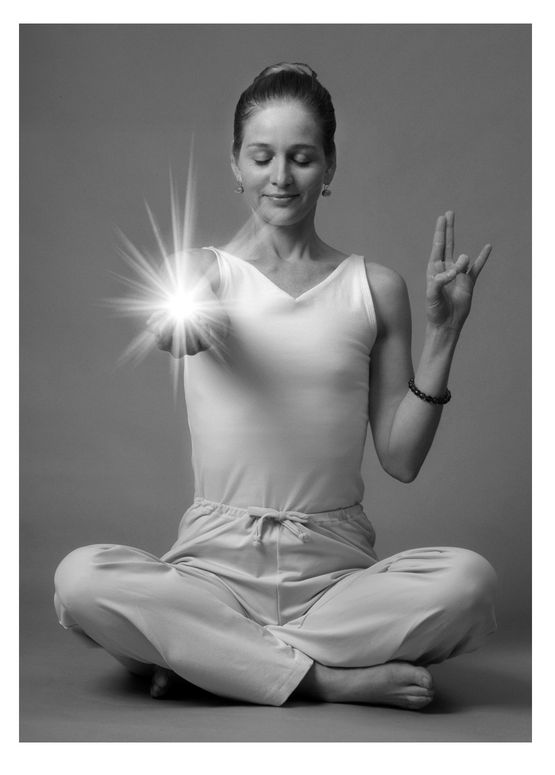Table of Contents
Foreword by Michael McGee, M.D.
PHOTOGRAPHS BY RALPH MERCER
Avery
a member of
Penguin Group (USA) Inc.
New York
For Yogi Bhajan
And my husband, Dave Frank
Acknowledgments
I first want to express my deep and heartfelt gratitude to Yogi Bhajan for bringing the teachings of Kundalini Yoga for women to the United States. His tireless dedication to uplifting women remains a continual inspiration to me.
This project would not be possible without the support of the editorial staff at Penguin Books. I express my gratitude and thanks to Kristen Jennings for her belief in this project and to Rebecca Behan for her support and great editing, and Anna Ghosh, my literary agent, for her support.
Thanks to the beautiful Shelly Loheed for being the model for this book; her dedication and commitment to this project and to the teachings of Kundalini Yoga and meditation radiate from every photograph. I also thank Ralph Mercer for his artistic dedication to yoga photography, stylist Paula Dion, the Kundalini Research Institute for its commitment to sharing the teachings of Yogi Bhajan, my fellow yoga teachers and teacher trainers, and the many students who through their dedication continue to give me the opportunity to teach. Thanks to Sat Bir Singh Khalsa, research scientist at Harvard Medical School, for his knowledge of the body of scientific research as it pertains to yoga and meditation. Grateful thanks to Lea Kramer for her assistance with Sanskrit notations, Dharm for his timely research and more, Dr. Michael McGee for bridging East and West in his work with his patients and sharing this important work in the foreword of this book, Irene Frank for her open heart and open mind, and Machelle M. Seibel, M.D., for his partnership on the first book of this series, A Womans Book of Yoga: Embracing Our Natural Life Cycles.
Foreword
Meditation is the foundation of all spiritual practices and traditions. What has been known throughout the ages by sages from every time and place is now the subject of scientific inquiry. We now know that meditation actually changes the brain. Neuroimaging studies show, among other things, greater overall brain-wave synchrony and increased metabolism in experienced meditators. These studies confirm that changes in states of consciousness produced by meditation correlate with changes in brain states. This exciting research holds great promise for elucidating the neuroanatomy and neurophysiology of enhanced states of consciousness. There is also a wealth of clinical research that demonstrates an association between meditation, health, and well-being.
Of course, weve always known, anecdotally, that people who meditate tend to live happier, healthier lives. The practice of giving gentle and loving attention to this present moment through contemplative, concentrative, or mindfulness techniques results in beneficial changes in consciousness and in overall health. Through meditative practices we learn to dis-identify with our time-based thoughts and feelings and instead learn to simply Be. In this state our minds open up. We learn not to judge our experiences. We gradually understand that our thoughts and feelings alone do not define us. We begin to experience greater peace, love, and the simple joy of existence. We are more conscious of the miraculous wonder of being alive. We develop a deeper knowing, or intuition, of what is true and right for us in each moment. And as we grow in meditation we begin to act out of that deeper knowing rather than in response to what we happen to be thinking and feeling.
I personally discovered meditation when I was in medical school at Stanford University in 1979. My own practice has brought about both a change in consciousness for me and has also influenced my work with my patients. It has taught me to not take my thoughts quite so seriously and not be quite so judgmental (or at least to notice when my mind does judge!). Ive gradually learned to be more present more of the time throughout the day. This gives a directness and clarity to my awareness. Ive come to see the mind as a tool that I use, rather than allowing my mind to use me. My practice serves as a spring of energy that works to renew and refresh each day.
I regularly teach meditative exercises to my patients and encourage them to incorporate a meditative practice into their daily lives. I have seen countless patients benefit medically from these efforts as they gradually develop a greater sense of peace, equanimity, and perspective in their lives. Over and over again Ive observed that their treatment just seems to go better when my patients make the effort to meditate on a daily basis. Often problems and conflicts just seem to dissolve away in the stillness that accompanies awareness. My patients tell me they are happier and more loving toward othersand they typically find that their health improves along with their mood. As with any major lifestyle change I recommend to my patients, the challenge lies in guiding and motivating people to develop the discipline of a regular spiritual practice. For many people, this simply goes against the grain of their busy, activity-focused lives. And that, of course, is exactly the point!
Ours is a time of great paradox. We live in a world of astounding material abundance but in a time of great perilboth consequences of the human mind. Despite our material comforts, our many pleasures, and our increased longevity, people on the whole seem no happier than they were two hundred years ago. Perhaps happiness and well-being spring from a wisdom that lies beyond and beneath the fruits of the mind, a wisdom that can only be tapped through a practice of meditation. Our culture is currently out of balance, with too much activity and not enough solitude and stillnessthe ground out of which wisdom grows.
This book addresses not only meditation but the special needs of women pursuing a meditative practice. Women have special gifts and unique psychological attributes. As a rule, women are more connected than men to the experience of Being and to their emotions.
Women face special challenges as well. The hormonal shifts in a womans body create special physical and emotional states. Women, more often than men, face the challenge of being the primary caregiver in the family while also pursuing a career.
I have known Hari Kaur Khalsa for a number of years. Her own practice of meditation, combined with her gifts for writing and teaching, make her uniquely qualified to write this book. Here she shares with you her wisdom and the benefits of the practice that she has personally touched so many lives with.
May this book be a resource to change the lives of women looking to enhance their happiness and well-being through the practice of meditation.
Michael McGee, M.D.
Introduction
Everything depends on your mental outlook.... All of your experience is filtered through the creativity and appraisal of your mind. Happy and unhappy belong to your mind, not to the world.YOGI BHAJAN
Kundalini Yoga is a total practice that includes exercises and yoga postures, meditation, and deep relaxation. This book explores the powerful healing techniques of Kundalini Yoga Meditation in a format designed specifically for women. Throughout the book you will learn how to use meditation to help you develop a positive self-image and heal negative patterns of thinking and self-limiting belief systems.


